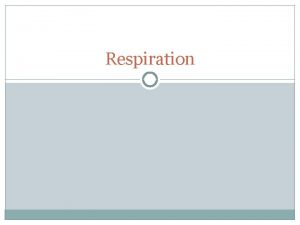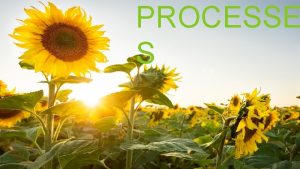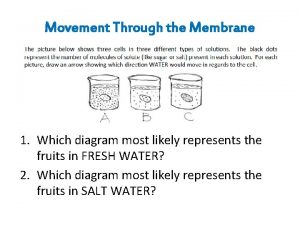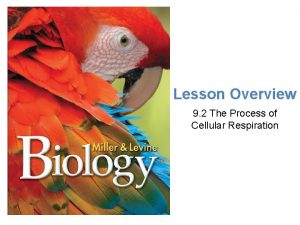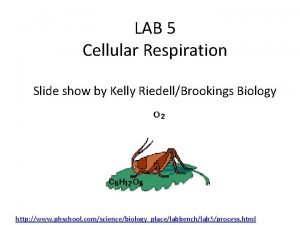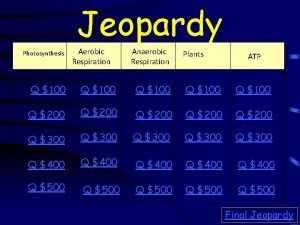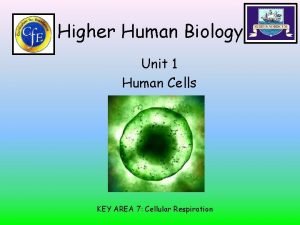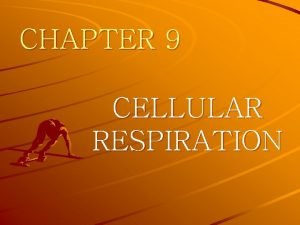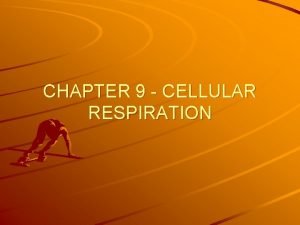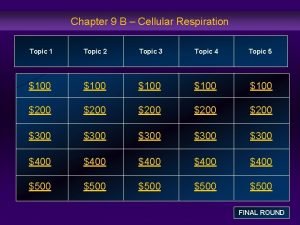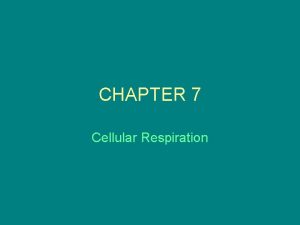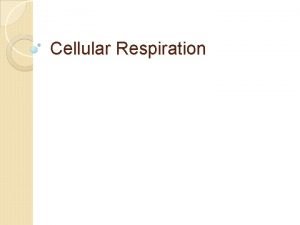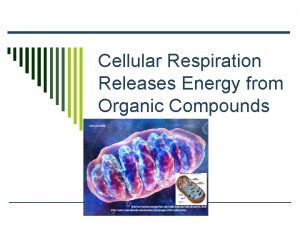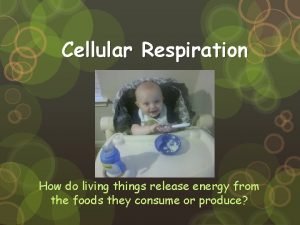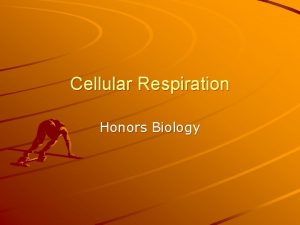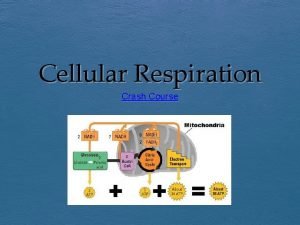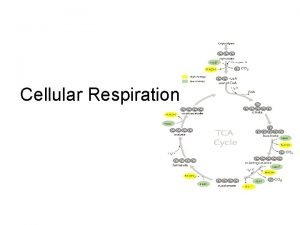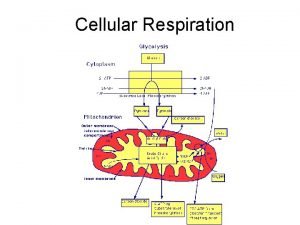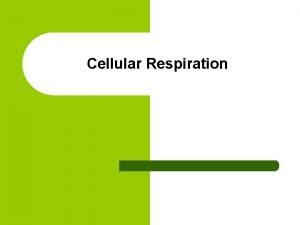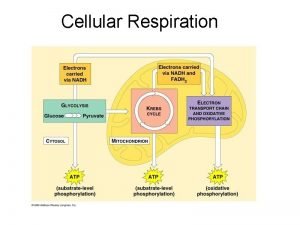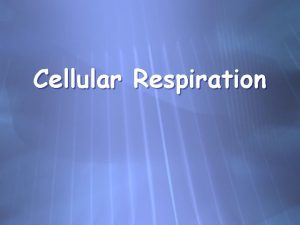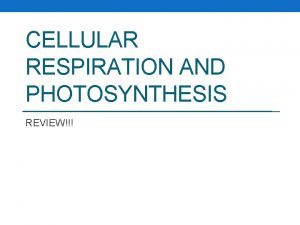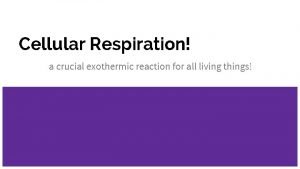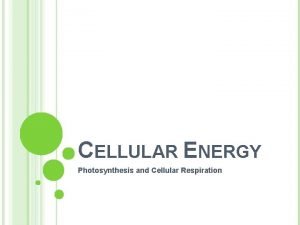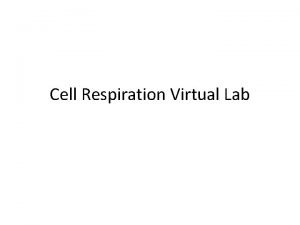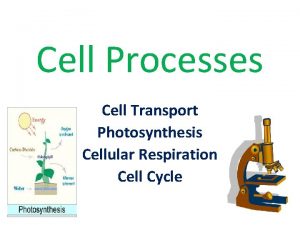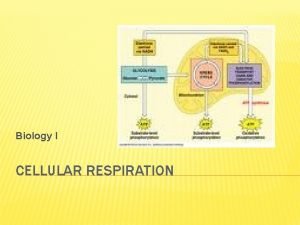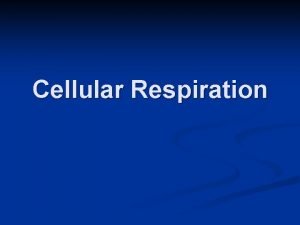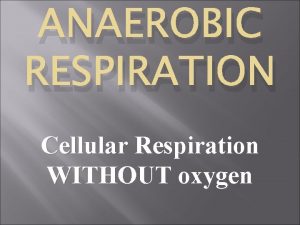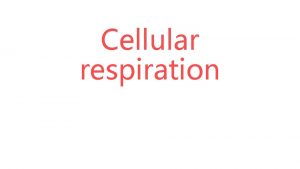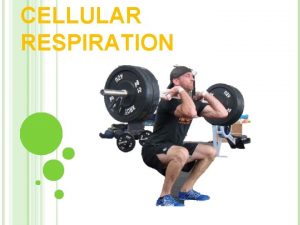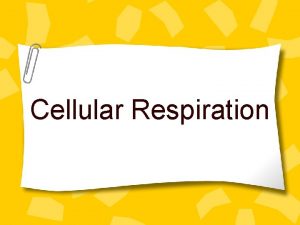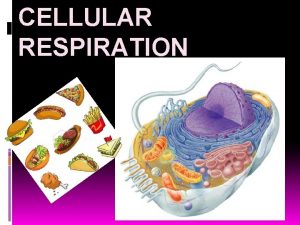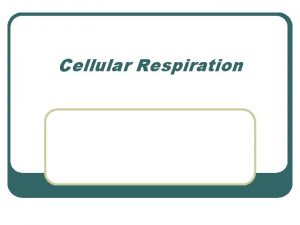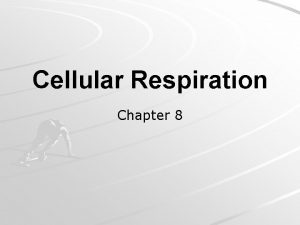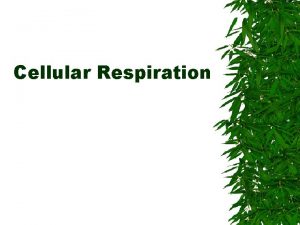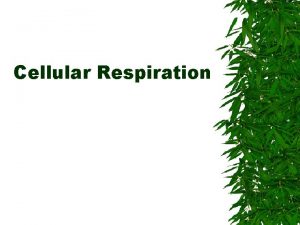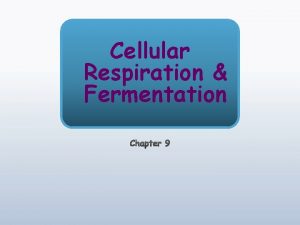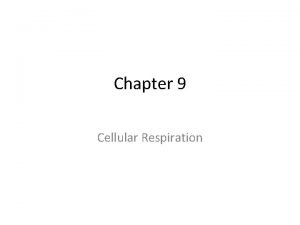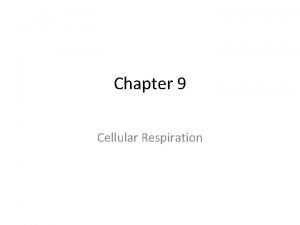Lesson Overview Cellular Respiration An Overview Lesson Overview










































- Slides: 42

Lesson Overview Cellular Respiration: An Overview Lesson Overview 9. 1 Cellular Respiration: An Overview

Lesson Overview Cellular Respiration: An Overview Chemical Energy and Food provides living things with the chemical building blocks they need to grow and reproduce. Food molecules contain chemical energy that is released when its chemical bonds are broken.

Lesson Overview Cellular Respiration: An Overview Chemical Energy and Food Energy stored in food is expressed in units of calories. A calorie is the amount of energy needed to raise the temperature of 1 gram of water by 1 degree Celsius. 1000 calories = 1 kilocalorie, or Calorie. Cells use all sorts of molecules for food, including fats, proteins, and carbohydrates. The energy stored in each of these molecules varies because their chemical structures, and therefore their energy-storing bonds, differ. Cells break down food molecules gradually and use the energy stored in the chemical bonds to produce compounds such as ATP that power the activities of the cell.

Lesson Overview Cellular Respiration: An Overview of Cellular Respiration If oxygen is available, organisms can obtain energy from food by a process called cellular respiration. The summary of cellular respiration is presented below. In symbols: 6 O 2 + C 6 H 12 O 6 6 CO 2 + 6 H 2 O + Energy In words: Oxygen + Glucose Carbon dioxide + Water + Energy The cell has to release the chemical energy in food molecules (like glucose) gradually, otherwise most of the energy would be lost in the form of heat and light.

Lesson Overview Cellular Respiration: An Overview Stages of Cellular Respiration The three main stages of cellular respiration are: • glycolysis • the Krebs cycle • the electron transport chain

Lesson Overview Cellular Respiration: An Overview Stages of Cellular Respiration Glycolysis produces only a small amount of energy. Most of glucose’s energy (90%) remains locked in the chemical bonds of pyruvic acid at the end of glycolysis.

Lesson Overview Cellular Respiration: An Overview Stages of Cellular Respiration During the Krebs cycle, a little more energy is generated from pyruvic acid.

Lesson Overview Cellular Respiration: An Overview Stages of Cellular Respiration The electron transport chain produces the bulk of the energy in cellular respiration by using oxygen, a powerful electron acceptor.

Lesson Overview Cellular Respiration: An Overview Oxygen and Energy Pathways of cellular respiration that require oxygen are called aerobic. The Krebs cycle and electron transport chain are both aerobic processes. Both processes take place inside the mitochondria.

Lesson Overview Cellular Respiration: An Overview Oxygen and Energy Gylcolysis is an anaerobic process. It does not directly require oxygen, nor does it rely on an oxygenrequiring process to run. However, it is still considered part of cellular respiration. Glycolysis takes place in the cytoplasm of a cell.

Lesson Overview Cellular Respiration: An Overview Comparing Photosynthesis and Cellular Respiration Photosynthesis and cellular respiration are opposite processes. The energy flows in opposite directions. Photosynthesis “deposits” energy, and cellular respiration “withdraws” energy. The reactants of cellular respiration are the products of photosynthesis and vice versa.

Lesson Overview Cellular Respiration: An Overview Comparing Photosynthesis and Cellular Respiration The release of energy by cellular respiration takes place in plants, animals, fungi, protists, and most bacteria. Energy capture by photosynthesis occurs only in plants, algae, and some bacteria.

Lesson Overview Cellular Respiration: An Overview Lesson Overview 9. 2 The Process of Cellular Respiration

Lesson Overview Cellular Respiration: An Overview Glycolysis is the first stage of cellular respiration. During glycolysis, glucose is broken down into 2 molecules of the 3 -carbon molecule pyruvic acid. Pyruvic acid is a reactant in the Krebs cycle. ATP and NADH are produced as part of the process.

Lesson Overview Cellular Respiration: An Overview ATP Production The cell uses 2 ATP molecules into its “account” to get glycolysis going. Glycolysis then produces 4 ATP molecules, giving the cell a net gain of 2 ATP molecules for each molecule of glucose that enters glycolysis.

Lesson Overview Cellular Respiration: An Overview NADH Production During glycolysis, the electron carrier NAD+ accepts a pair of high-energy electrons and becomes NADH carries the high-energy electrons to the electron transport chain, where they can be used to produce more ATP. 2 NADH molecules are produced for every molecule of glucose that enters glycolysis.

Lesson Overview Cellular Respiration: An Overview The Advantages of Glycolysis produces ATP very fast, which is an advantage when the energy demands of the cell suddenly increase. Glycolysis does not require oxygen, so it can quickly supply energy to cells when oxygen is unavailable.

Lesson Overview Cellular Respiration: An Overview The Krebs Cycle During the Krebs cycle, the second stage of cellular respiration, pyruvic acid produced in glycolysis is broken down into carbon dioxide in a series of energy-extracting reactions. The Krebs cycle is also known as the citric acid cycle because citric acid is the first compound formed in this series of reactions.

Lesson Overview Cellular Respiration: An Overview Citric Acid Production Pyruvic acid from glycolysis enters the matrix, the innermost compartment of the mitochondrion.

Lesson Overview Cellular Respiration: An Overview Citric Acid Production Once pyruvic acid is in the mitochondrial matrix, NAD+ accepts 2 high-energy electrons to form NADH. One molecule of CO 2 is also produced. The remaining 2 carbon atoms react to form acetyl-Co. A.

Lesson Overview Cellular Respiration: An Overview Citric Acid Production Acetyl-Co. A combines with a 4 -carbon molecule to produce citric acid.

Lesson Overview Cellular Respiration: An Overview Energy Extraction Citric acid is broken down into a 5 -carbon compound and then a 4 -carbon compound. Two molecules of CO 2 are released. The 4 -carbon compound can then start the cycle again by combining with acetyl-Co. A.

Lesson Overview Cellular Respiration: An Overview Energy Extraction Energy released by the breaking and rearranging of carbon bonds is captured in the forms of ATP, NADH, and FADH 2.

Lesson Overview Cellular Respiration: An Overview Energy Extraction For each turn of the cycle, one ADP molecule is converted into ATP can directly power the cell’s activities.

Lesson Overview Cellular Respiration: An Overview Energy Extraction The electron carriers NAD+ and FAD each accept pairs of high-energy electrons to form NADH and FADH 2 are used in the electron transport chain to generate ATP.

Lesson Overview Cellular Respiration: An Overview Energy Extraction Remember! Each molecule of glucose results in 2 molecules of pyruvic acid, which enter the Krebs cycle. So each molecule of glucose results in two complete “turns” of the Krebs cycle. Therefore, for each glucose molecule, 6 CO 2 molecules, 2 ATP molecules, 8 NADH molecules, and 2 FADH 2 molecules are produced.

Lesson Overview Cellular Respiration: An Overview Electron Transport NADH and FADH 2 pass their high-energy electrons to electron carrier proteins in the electron transport chain.

Lesson Overview Cellular Respiration: An Overview Electron Transport At the end of the electron transport chain, the electrons combine with H+ ions and oxygen to form water.

Lesson Overview Cellular Respiration: An Overview Electron Transport Energy generated by the electron transport chain is used to move H+ ions against a concentration gradient across the inner mitochondrial membrane and into the intermembrane space.

Lesson Overview Cellular Respiration: An Overview ATP Production H+ ions pass back across the mitochondrial membrane through the ATP synthase, causing the ATP synthase molecule to spin. With each rotation, the ATP synthase attaches a phosphate to ADP to produce ATP.

Lesson Overview Cellular Respiration: An Overview Energy Totals In the presence of oxygen, the complete breakdown of glucose through cellular respiration results in the production of 36 ATP molecules. This represents about 36 percent of the total energy of glucose. The remaining 64 percent is released as heat.

Lesson Overview Cellular Respiration: An Overview Energy Totals The cell can generate ATP from just about any source, even though we’ve modeled it using only glucose. Complex carbohydrates are broken down into simple sugars like glucose. Lipids and proteins can be broken down into molecules that enter the Krebs cycle or glycolysis at one of several places.

Lesson Overview Cellular Respiration: An Overview Lesson Overview 9. 3 Fermentation

Lesson Overview Cellular Respiration: An Overview Fermentation is a process by which energy can be released from food molecules in the absence of oxygen. Fermentation occurs in the cytoplasm of cells.

Lesson Overview Cellular Respiration: An Overview Fermentation Under anaerobic conditions, fermentation follows glycolysis. During fermentation, cells convert NADH produced by glycolysis back into the electron carrier NAD+, which allows glycolysis to continue producing ATP.

Lesson Overview Cellular Respiration: An Overview Alcoholic Fermentation Yeast and a few other microorganisms use alcoholic fermentation that produces ethyl alcohol and carbon dioxide. This process is used to produce alcoholic beverages and causes bread dough to rise.

Lesson Overview Cellular Respiration: An Overview Alcoholic Fermentation Chemical equation: Pyruvic acid + NADH Alcohol + CO 2 + NAD+

Lesson Overview Cellular Respiration: An Overview Lactic Acid Fermentation Most organisms, including humans, carry out fermentation using a chemical reaction that converts pyruvic acid to lactic acid. Chemical equation: Pyruvic acid + NADH Lactic acid + NAD+

Lesson Overview Cellular Respiration: An Overview Energy and Exercise How does the body produce ATP during different stages of exercise? For short, quick bursts of energy, the body uses ATP already in muscles as well as ATP made by lactic acid fermentation. For exercise longer than about 90 seconds, cellular respiration is the only way to continue generating a supply of ATP.

Lesson Overview Cellular Respiration: An Overview Quick Energy Cells normally contain small amounts of ATP produced during cellular respiration, enough for a few seconds of intense activity. Lactic acid fermentation can supply enough ATP to last about 90 seconds. However, extra oxygen is required to get rid of the lactic acid produced. Following intense exercise, a person will huff and puff for several minutes in order to pay back the built-up “oxygen debt” and clear the lactic acid from the body.

Lesson Overview Cellular Respiration: An Overview Long-Term Energy For intense exercise lasting longer than 90 seconds, cellular respiration is required to continue production of ATP. Cellular respiration releases energy more slowly than fermentation does. The body stores energy in the form of the carbohydrate glycogen. These glycogen stores are enough to last for 15 to 20 minutes of activity. After that, the body begins to break down other stored molecules, including fats, for energy.

Lesson Overview Cellular Respiration: An Overview Long-Term Energy Hibernating animals, such as a brown bear, rely on stored fat for energy when they sleep through the winter.
 Overview of cellular respiration
Overview of cellular respiration Overview of respiration
Overview of respiration Cellular respiration
Cellular respiration Total atp produced in cellular respiration
Total atp produced in cellular respiration Cellular respiration redox
Cellular respiration redox The gray-brown haze often found over large cities is called
The gray-brown haze often found over large cities is called Chemiosmosis steps
Chemiosmosis steps Where is aerobic respiration located
Where is aerobic respiration located Fermentation definition biology
Fermentation definition biology Why is cellular respiration important
Why is cellular respiration important Complimentary processes
Complimentary processes Chemical equation for cellular respiration
Chemical equation for cellular respiration How are internal and external respiration alike
How are internal and external respiration alike Equation for photosynthesis
Equation for photosynthesis Photosynthesis recipe card
Photosynthesis recipe card Electron carriers in cellular respiration
Electron carriers in cellular respiration Lab bench cellular respiration
Lab bench cellular respiration What is the word equation for cellular respiration
What is the word equation for cellular respiration Higher human biology cellular respiration
Higher human biology cellular respiration Equation for cellular respiration
Equation for cellular respiration Products of cellular respiration
Products of cellular respiration Cellular respiration releases
Cellular respiration releases Starting materials for cellular respiration
Starting materials for cellular respiration Chapter 8 section 3 cellular respiration continued
Chapter 8 section 3 cellular respiration continued Redox reaction in cellular respiration
Redox reaction in cellular respiration Cellular respiration formula
Cellular respiration formula Role of cellular respiration
Role of cellular respiration Cellular respiration releases
Cellular respiration releases Cellular respiration redox
Cellular respiration redox Respiration crash course
Respiration crash course Cellular respiration
Cellular respiration Process of cellular respiration
Process of cellular respiration Overall reaction of cellular respiration
Overall reaction of cellular respiration Where does cellular respiration take place
Where does cellular respiration take place Electron transport chain cellular respiration
Electron transport chain cellular respiration Where does cellular respiration take place
Where does cellular respiration take place Function of cellular respiration
Function of cellular respiration Cellular respiration endothermic or exothermic
Cellular respiration endothermic or exothermic What are the net products of the krebs cycle
What are the net products of the krebs cycle Formula for photosynthesis and cellular respiration
Formula for photosynthesis and cellular respiration Cellular respiration virtual lab snails and elodea
Cellular respiration virtual lab snails and elodea Pmat cell cycle
Pmat cell cycle What is the chemical formula of cellular respiration
What is the chemical formula of cellular respiration







